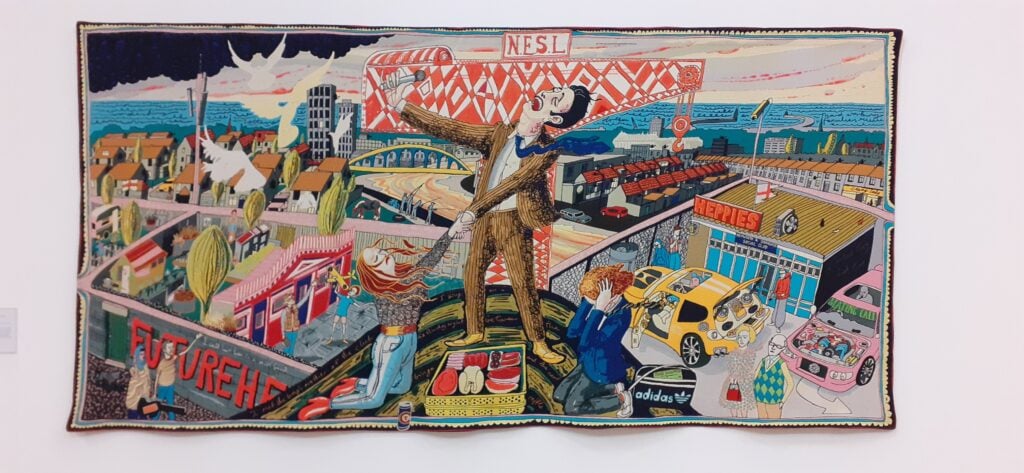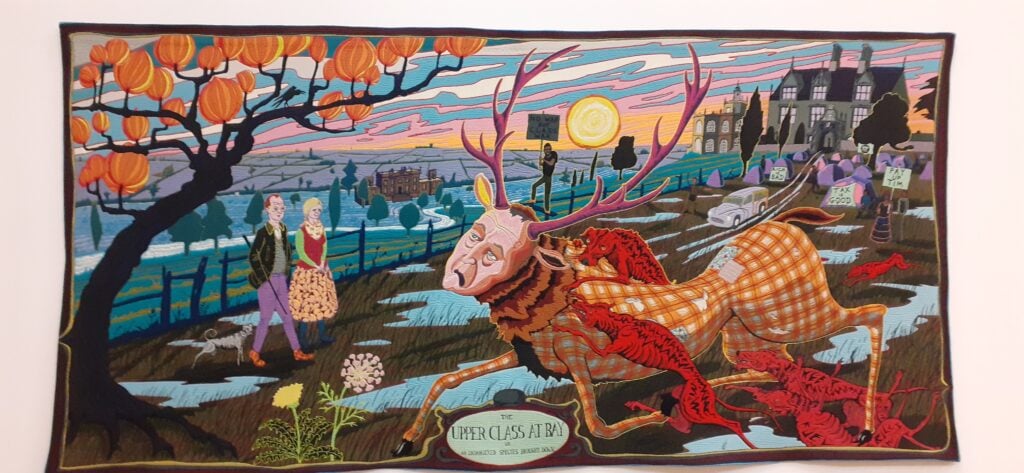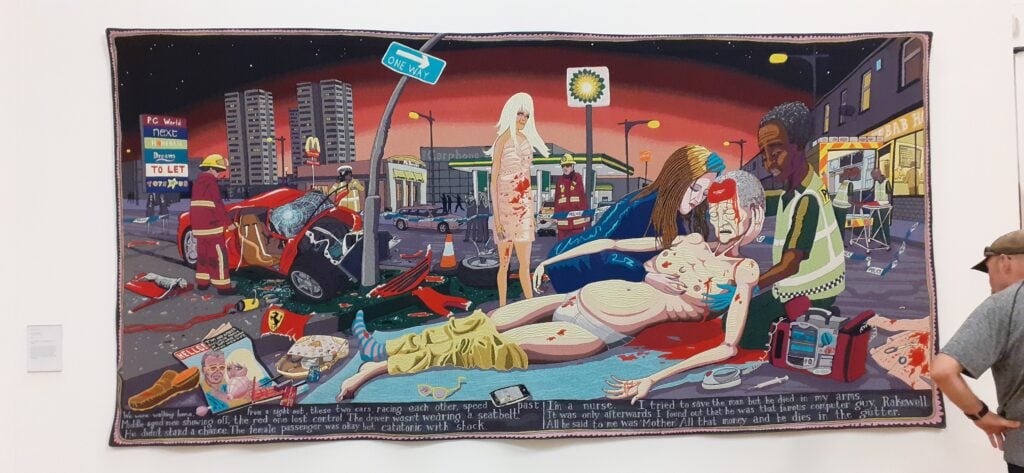
I was extremely excited to be able to visit “The Vanity of Small Differences” exhibition by Turner-Prize winning British artist Grayson Perry at the local Lincoln Gallery.
On loan from the Arts Council Collection, British Council and Southbank Centre, “The Vanity of Small Differences” exhibition is on at Lincoln Museum, Danes Terrace, Lincoln from Saturday 23rd September 2023 and continues until 21st January 2024.
In 2012 Grayson Perry created a documentary series, “All in the Best Possible Taste”, for Channel 4 which went on to win a BAFTA. Grayson travels around Britain – to Sunderland, Royal Tunbridge Wells and the Cotswolds – chatting to people he meets, asking questions, observing and exploring what is perceived by working, middle and upper-class tastes, and analysing ideas of taste held by different social classes by looking at what people eat, their possessions, views on status, wealth and education.
The six 2x4m tapestries were born from the experiences, emotions and observations by Grayson as he immersed himself into the cultures, people and areas he visited to try and understand the differences. The tapestries illustrate and narrate the life and tragic death of a fictional character, Tim Rakewell, as journeys from a working class beginning in Sunderland to a self-made computer millionaire in the Cotswolds. The 6 tapestries are filled with imagery, text and all the trappings of life, interwoven with the artist’s own life experiences and the people he’s encountered.
There are also numerous religious and historical influences, I am reminded of the great tapestries you see in grand houses, used to colour a room as well as keep out draughts, depicting stories from the bible, mythology, battles, events, classic stories or national transformative events such as the storytelling within the Bayeux tapestry which depicts the events leading up to the Norman Conquest of England in 1066. However rather than depicting a soldier on horseback with a sword you have a figure with a smartphone.
The tapestries were created through a mix of traditional materials and modern techniques; woven in Flanders from wool, cotton and silk and made on a computerised mechanical loom, then hand coloured by the artist.
The story is based on William Hogarth’s “A Rake’s Progress”, which are a series of paintings produced in 1732-34 and were published from engravings in 1735. These depict the decline and fall of Tom Rakewell, a rich merchant’s son, as he makes poor choices throughout his life by wasting all his money on luxurious living, gambling, and prostitution.
These tapestries can be appreciated on various levels, presenting an intricate narrative and story of the main character interwoven with historical, religious, and modern imagery. Grayson Perry uses them to make statements about society, encompassing both the past and present, while hinting at possible futures all within the same scene. Similar themes are evident throughout all the tapestries, including a dominant colour scheme of red, yellow, and blue. Recognisable brands and products are featured, drawing attention to consumerism. Religious imagery is present, with the depiction of the mother holding the baby in the pose of the Madonna and child. The weather is used to convey various emotional atmospheres within a scene, spanning from a lively rainbow to a foreboding, menacing sky with lightning bolts. The concluding shades of red in the ultimate image, along with the recurring motif of the rising and setting sun, are elements that endure throughout the panels.
The Adoration of the Cage Fighters

The narrative of the mother runs around the room and the first tapestry, titled “The Adoration of the Cage Fighters,” depicts Tim, a baby, and his mother as the key figures. Tim’s mother could have gone to university but faces life as a single parent as his father left soon after Tim was born. Through the commentary which ribbons around the key figures, you discover the dynamics of the family, with issues like drink, divorce, unemployment, mental illness, addiction, and domestic violence. Through all this it is Nan who is “the salt of the earth” and her friends who keep her sane. Surrounded with the trappings of modern life; a cell phone in the mother’s hand and a remote control and energy drink on a nearby table, in the background are pictures of Sunderland, its dockland and shipbuilding heritage, and tiny ceramic angels on the fire surround. Kneeling in front of the mother are two tattooed figures, mixed martial artists, presenting gifts – icons of their class identity – of a tiny red and white striped Sunderland football shirt and a miner’s lamp. It is the positioning of the mother as the largest and most central figure with Baby Tim in her arms, and the kneeling figures are reminiscent of the Christian iconology of the Adoration of the Magi the nativity scene where Christ, sat on his mother’s knee is presented with gifts by The Magi or three Kings.
The Agony in the Car Park

Moving on to the next part of Tim’s life in “The Agony in the Car Park.” The central and narrative figure is Tim’s stepfather, as the text on the hill he is standing on explains. He “sings on a Saturday night between the bingo and the meat raffle. His stepfather expresses a desire to “get out” from his working-class beginnings and is hopeful after earning good money in a call centre and being described as management material
This panel is brimming with familiar landmarks and activities of the city of Sunderland. It captures the essence of the locale, showcasing elements such as shipbuilding, the prominent Stadium of Light, the distant Roker Lighthouse, and the railway bridge spanning the River Wear, where a group can be seen fishing below. The scene transitions from terraced streets to tower blocks, modern newly constructed estates, and hoodie-clad youngsters customising their cars.
An embarrassed Tim, with hands over his ears, is dressed in grammar school uniform and there is a hint of his future as a copy of “Your Computer” is peeking out of his Adidas bag, displaying an early enthusiasm for software. There are also personal references to influences in Tim’s life as he flies a plane with his grandfather and cleverly woven into the textures and waves of the North Sea are words like ‘destiny’, ‘dream’, ‘hard-working’ and ‘families’.
Expulsion from Number 8 Eden Close

Tim is now at university and has a girlfriend from Tunbridge Wells, whose commentary is in the text. This tapestry is called “Expulsion from Number 8 Eden Close” and Tim, clutching an iPhone, and his girlfriend leave a dark and stormy past after an argument with his parents, presumably about his newfound ‘snobbishness’, and pass through a rainbow into the “sunlit uplands of the middle classes”. The symbol of the sun, in this panel radiating image of new beginnings, in the top right-hand corner is in stark contrast to the storm and thunder sky on the left, with a grinning portrait of Jamie Oliver, mentioned in the text as worshipped like a god by Tim’s mother.
The left-hand scene shows that despite Tim’s mother’s own protestations she has also experienced some small upward social mobility thanks to his stepfather’s success in the previous tapestry. She is no longer living with family as a single mother but now lives on a modern estate, owns a luxury car and is vacuuming her astroturf. Tim is welcomed by his girlfriend’s middle-class family with raised glasses, though his accent is laughed at. The sun symbol will reoccur in the next tapestries.
The Annunciation of the Virgin Deal

Tim now reclines in a large rural home, now a wealthy family man after selling his business to Virgin, as the news screen on the tablet on the table announces, with portraits of Bill Gates and Steve Jobs are prominently displayed behind the sofa where Tim is sitting. In “The Annunciation of the Virgin Deal,” the text in the voice from Tim’s business partner(in yellow), we see Tim at home with the family with a baby cradled in Tim’s arms and a small child playing on a rug. It seems a settled and comfortable family scene, the in-laws seated in the window, organic vegetables on the table, and baby clothes drying on a dryer, but there are still suggestions of discord and confusion in the commentary woven into the words explain that Tim is incredibly driven, but he never feels successful. This is the family’s second home in the country with trappings of a more affluent lifestyle and the cushion next to where Tim is sitting bears the quotation “Bourgois and Proud” but in contrast to this and the centre of the piece a mug with the words Class Traitor. The imagery of the sun is the centre of the scene, as a clock, with full radiating rays.
The Upper Class at Bay

Moving forward again, the children have left home and Tim and his wife, now in their 40s, take a stroll in the countryside, in the grounds of their Cotswold mansion, with the sun setting just on the horizon. An old aristocratic stag is being hunted by the blood-red dogs of Tax, Upkeep, Social Change and Fuel bills. Tim and his family are new money but will never be upper class as they are. Though Tim has made his money he has his own issues, it is not all sunshine and roses as the wet and dismal atmosphere alludes to. There are protesters with slogans like “Rich is bad,” “Tax is good,” “Pay Up Tim” and “No war but Class war.”
#Lamentation

The final piece “#Lamentation”, meaning the passionate expression of grief or sorrow, records the tragic demise of Tim Rakewell, as you see him crushed and battered cradled in a nurse’s arms, who is the voice of the text for this final piece. After crashing his brand new Ferrari, Tim lies dying in a stranger’s arms as his younger new wife, whose high fashion branded bag lays scattered on the floor next to the Ferrari badge and a copy of Hello magazine with a story about the couple on the front cover stand by in shock. Onlookers take pictures with their smartphones. Tim stripped of his clothing brings it home that we are all vulnerable. A report of the incident is woven into the bottom of the piece explaining what happened and how he made his money in computers and ties together all the parts of the story. The scene is reminiscent of biblical painting as Christ is lifted from the cross. A Poignant final phrase which says a lot “All that money and he died in the gutter.”
“The vanity of small differences” says it all: we use small differences to set ourselves apart throughout class and society. The images are cluttered with things, things from the past, things which have important sentimental meaning to the people and things which are a statement and set the individuals apart from one another.
I left with my head spinning with questions about assumptions of class and society through this tale of morality, and a little sad. The stitched-in commentary told by different voices, helped to explain a great deal about each of the tapestries and much of the imagery was recognisable to support the commentary. I would never try to understand everything the artist is trying to say through these pieces and nor would I want to, as these work on so many levels that each viewer will take something different away with them. I admire the energy and the imagination in these as well as the amazingly talented craftsmanship taken to create these tapestries which are packed with details and texture at every square inch of the large-scale pieces. Everywhere you look there is something different and it is like reading a story full of ups and downs twists and turns, which touch you on a very personal level.
Grayson Perry’s exhibition inspired me to create a series of small sketches that represent my story. You will notice that there is a constant presence of cats throughout my story.

The museum is open Thursday to Monday from 10 am to 4 pm. Plan your visit now at www.lincolnmuseum.com.